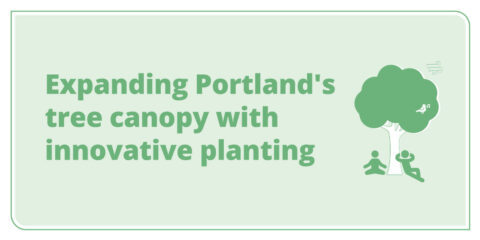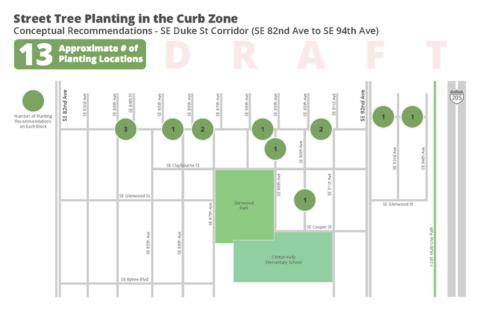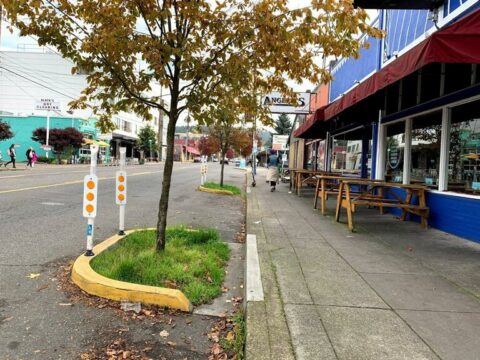Trees in the Curb Zone:
PBOTs Innovative Pilot Program to Enhance Portland’s Tree Canopy

As summer approaches and temperatures rise, the Portland Bureau of Transportation (PBOT) is launching a groundbreaking initiative aimed at transforming our city’s streetscape: the “Trees in the Curb Zone” pilot project. This innovative project, supported by a $500,000 grant from the Bureau of Environmental Services’ “Percent for Green” program, seeks to enhance urban walkability and combat the effects of urban heat islands by introducing more greenery into our curb zones. Portland Parks and Recreation’s Urban Forestry is also a partner on this project, providing technical expertise and long-term maintenance of the trees.
Oregon Walks recently sat down with PBOT’s Pedestrian Realm Coordinator, Gena Gastaldi, to learn more about this innovative project..
A Vision Born from Necessity
The 2021 heat dome in Portland was one of the catalysts for this pilot project, drawing attention to the urgent need for urban cooling solutions. During this crisis, the absence of shade in many neighborhoods underscored the vulnerability of urban populations to extreme heat. Gastaldi reflected on the project’s origins, noting, “We lost community members… Everyone needs to be doing as much as they can to create more space for trees to mitigate urban heat islands”.The Pedestrian Design Guide and PedPDX, the city’s pedestrian master plan, provided the policy basis for this program.
What is “Trees in the curb zone?”
There is often not enough space for trees between the sidewalk and curb, known as the “furnishing zone.” “Trees in the curb zone” allows PBOT to reallocate on street parking spaces and replace them with large bump outs for street trees.
The project will start with a pilot on SE Duke St in the Lents neighborhood. Gastaldi describes the pilot program as consisting of two phases. In phase one, about 10 large bump outs will be constructed and 13 trees will be planted on SE Duke St in the curb zone (see diagram). In addition to the trees planted in the curb zone, residents along the street will be offered free yard trees for their own properties. Construction of the project is set to begin in summer 2024 with planting set to occur in the fall. In phase two, the team will analyze planting locations on streets near Lents Park and Bloomington Park, where they plan to construct bump outs and plant an additional 15-20 trees in the curb zone.

Phase 1 trees per block design for SE Duke St planting plan.
The bump outs being constructed will range from 20 feet to 80 feet long, with room for 1 to 3 trees in each.

To get a glimpse of what “Trees in the Curb Zone” might look like, you can visit SE Hawthorne! These trees were planted over a decade again. While the Duke bump outs will be much larger, this gives you an idea of what the project will look like.
Long Term Care
Maintenance was a priority consideration. While maintenance duties are usually fulfilled by the adjacent property owners, the trees planted in the pilot program will be provided and managed by the Portland Parks & Recreation’s Urban Forestry team. Nearby property owners will also be provided with ways to report any problems related to the trees. Given that this project aims to improve the livability for residents, the support of the community was essential. Gastaldi highlighted that community members have shown great enthusiasm, with dozens of requests for similar treatments in other neighborhoods. The interest extends beyond Portland, with inquiries from cities such as Los Angeles, New York, Seattle, and Chattanooga, all wanting to hear more about the program and potentially replicate it in their cities.
Benefits and Goals
Benefits to Pedestrians
For pedestrians, the benefits of the “Trees in the Curb Zone” program are manifold:
- Temperature Regulation: Community partners will monitor temperature changes to ensure that the new trees provide effective cooling and shade.
- Safety and Comfort: The trees will act as a physical buffer between pedestrians and vehicular traffic, enhancing safety and comfort for those on foot. PBOT will also monitor before and after traffic speeds volumes to see if this pilot impacts driving behavior.
- Enhanced Walkability: Shaded sidewalks and visually appealing streetscapes will encourage more walking and outdoor activities, fostering a healthier community.
Near-Term Goals:
- Efficient allocation of the $500,000 grant.
- Initiating Phase One construction this summer with tree planting scheduled for the fall.
- Selecting and preparing Phase Two planting locations, particularly around Lents Park and Bloomington Park.
Long-Term Goals:
- Transitioning the pilot into a permanent program.
- Creating a replicable model with standard procedures for future implementation.
Conclusion
While this is a pilot program and requests for installations are not yet open to the public, Gastaldi urges residents to stay informed and express their interest as the program progresses. The long-term vision is to develop a scalable model that communities can adopt and request for their streets.
The “Trees in the Curb Zone” pilot project represents a significant step toward making Portland’s streets more walkable, livable, and resilient to climate change. By integrating trees into curb zones, PBOT is enhancing the urban landscape and setting a precedent for sustainable urban development. At Oregon Walks, we are excited to support, follow, and promote the progress of this transformative initiative.
For more information, visuals, and updates, visit the Trees in the Curb Zone Pilot Project page.
Together, let’s walk towards a greener, cooler, and safer Portland!
